Texas Railroad History - Tower 100 - Elgin
A Crossing of the Houston & Texas Central Railway and the Missouri, Kansas
& Texas Railway

Above: Southern
Pacific #894 obscures the Elgin Union Depot in the background as it passes Tower 100 eastbound in this undated photo. (Bruce Wilson
collection) Below: John W.
Barriger III took this photo of Tower 100 from the rear platform of his business car
sometime in the 1930s or perhaps the early 1940s. His camera is facing north
as his train proceeds south on the Missouri-Kansas-Texas Railway main line
toward
Smithville. The tower sat in the southeast quadrant of the crossing, diagonally across
from Elgin Union Depot. (John W Barriger III National Railroad Library)

The Galveston & Red River (G&RR) Railway was chartered
in 1848 with a grand plan to connect the port of Galveston with the Red River. Railroads from the Midwest were
anticipated to bridge the river and enter Texas from Indian Territory
(Oklahoma) creating an important export route for grain and other
commodities. Unable to raise
sufficient capital, the project languished until an unrelated opportunity arose:
farming interests in Chappell Hill needed better transportation to the
Houston market. Chappell Hill was only sixty miles
northwest of Houston but it was west of the flood-prone Brazos River, a wide and formidable obstacle.
A meeting was held in 1852 to discuss Chappell Hill's transportation issues;
Paul Bremond, one of the founders of the G&RR, attended. He suggested that in
exchange for financial backing from Chappell Hill investors, the G&RR could be
re-chartered to start construction in Houston and pass near Chappell Hill,
remaining east of the Brazos. A branch line would be needed since crossing
the Brazos was unnecessary for the G&RR to reach the Red River. Bremond's proposal was accepted and the
Legislature approved the change in 1853.
In 1856, the G&RR completed its first 25 miles
out of Houston to Cypress, arriving there just as the Legislature approved another
charter amendment granting the railroad a new name,
the Houston & Texas Central (H&TC) Railway. Much to the chagrin of
Chappell Hill's resident investors, the amendment prohibited H&TC from building branch lines until the
tracks to the Red River were completed. But the outlook was not completely bleak
for Chappell Hill because a plan was being developed by businessmen in the
nearby town of
Brenham to build a railroad to connect to the H&TC.
The Washington County Rail Road (WCRR) would pass through Chappell Hill as it
headed toward a bridge to be built over the Brazos River. The WCRR charter was granted
by the Legislature in February, 1856. By the end of
that year, the Hempstead Town Co. was being organized to sell lots at a town
site chosen to be the
connecting point for the WCRR.
 |
In 1858, the H&TC reached Hempstead from Cypress and continued
construction north toward Navasota. The
WCRR began construction westward from Hempstead in June, 1858 --
starting there allowed construction materials to be shipped from
Galveston by rail on the H&TC. Seven miles of track reaching the east bank of the Brazos
River was in place by early 1859. Bridging the Brazos took two
years; the first train from Hempstead to Chappell Hill ran in
early 1861. The WCRR line was finished soon thereafter with service into Brenham in April, 1861.
Left: Houston
Weekly Telegraph, February 5, 1861
As the Civil
War heated up, the H&TC terminated northward construction at Millican,
ten rail
miles north of Navasota. |
The WCRR continued operating during the War. Author S. G. Reed, in his classic reference
A History of the Texas Railroads (St. Clair
Publishing, 1941), explained that ultimately ...
"... it could not meet its
obligations and on June 2, 1868, was sold under foreclosure. The Sheriff
happened to be W. M. Sledge, the man who had built the road as a contractor, and
who owned three-fifths of the stock. He was the purchaser. The roadbed needed
repairs and the equipment was almost worn out, and the Washington County people
wanted it extended to the Capital at Austin. Sledge was not able to do so
himself, so on March 11, 1869, he sold it to the H. & T. C."
This was not Sledge's first rodeo ... railroad.
In 1867, he had been awarded the Buffalo Bayou, Brazos & Colorado (BBB&C)
Railway in
a court judgment for non-payment of his construction
contract (see Tower 17.) Sledge tried to operate the BBB&C before
selling it to Thomas Peirce in 1870. Peirce renamed it the Galveston,
Harrisburg & San Antonio (GH&SA) Railway and extended it to
San Antonio and
El Paso. Southern Pacific (SP) provided funding for the El Paso extension
and in 1883, leased and then acquired the GH&SA.
The WCRR had been supplying steady traffic at Hempstead, enough that the H&TC
had been willing to loan the WCRR $80,000 for repair work. Sledge extinguished this debt
by selling the WCRR. Although
the H&TC charter prevented the railroad from building branch lines until the main line to the Red River was
complete, the charter did not prevent the H&TC from investing in branch lines
being built under other railroad charters. The H&TC's
founders had long been projecting two major branch lines to the west, one of
which would go through
Austin continuing northwest to the Texas Panhandle. The purchase of the WCRR allowed the H&TC to get a head
start on this branch (which ultimately stopped at Llano and went no further.) The
construction to Austin began in 1870 when the H&TC built 42 miles from Brenham to
Hills (a community six miles west of Giddings.) The remaining 51
miles to Austin was built in 1871. The first train into
Austin arrived on Christmas Day, about a year before the H&TC's northward
construction reached Denison at the Red River.
The WCRR and the extension to Austin were
built at
state gauge,
5 ft. 6 in., as required by state law (narrow gauge, 3 ft., was
also permitted.) Many states (and the
Transcontinental Railroad) used standard gauge, 4 ft. 8.5 in.,
thus interstate traffic exchange was problematic for Texas railroads. In the early
1870s, state gauge fell into disfavor, and exceptions were already being permitted, e.g. the H&TC main line north of
Corsicana was built c.1871 at standard
gauge. By 1874, most Texas railroads were looking to switch to standard
gauge, and the law was changed in 1875.
Right: The
Denison Daily News of September 9, 1874 quotes the Houston Telegraph
celebrating the news that the H&TC was changing the Corsicana -
Hearne tracks to standard gauge. The
Telegraph
also noted that the Hearne - Hempstead tracks needed to be changed. A "third rail"
from Hempstead to Houston would then allow operations at both gauges, i.e. for Austin trains
at state gauge and for trains north of Hempstead at standard gauge. H&TC's
branch to Austin was converted to standard gauge in 1877. |
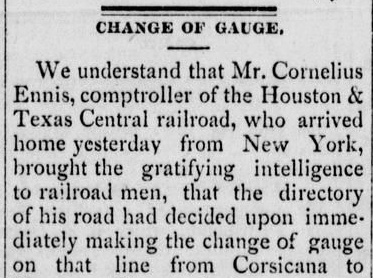 |
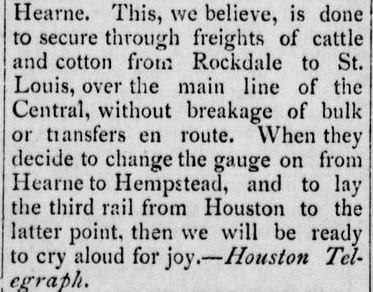 |
As the H&TC had built toward Austin in 1871, a new
settlement, Glasscock, became a flag stop in Bastrop County. When the town was platted in 1872,
the name was changed to Elgin in honor of Robert Elgin, the land commissioner
and surveyor for the H&TC. Elgin was fifteen miles
north of the county seat, Bastrop, which did not have rail service despite years
of trying to interest investors in building a line to Austin. Elgin, like
most small towns in east central Texas, had an economy based
on farming. In 1884, a brick manufacturing facility opened and Elgin soon
became widely known as a brick-making center, an industry ideally served by rail
transportation. Elgin's economy was further stimulated
when a second railroad began construction at Elgin in June, 1886.
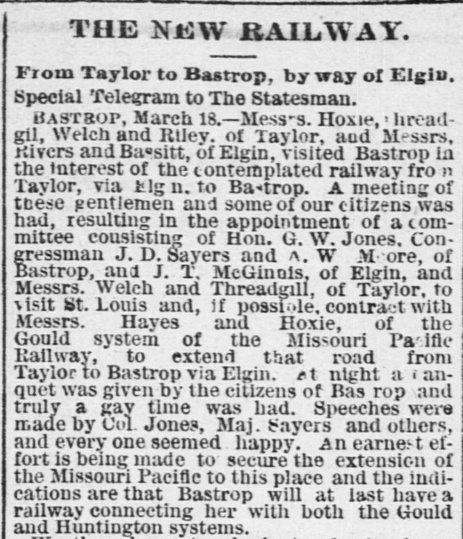 |
Left:
The Austin Weekly Statesman of
March 19, 1885 carried this story discussing a VIP meeting about a
potential railroad to run from Taylor to Bastrop, a 35-mile straight line with Elgin at the midpoint. The reporter
correctly surmised that the presence of Herbert M. "Hub" Hoxie, General
Superintendent of the International & Great Northern (I&GN) Railroad,
meant that rail baron Jay Gould was backing the plan. The "Huntington"
reference was to SP President C. P. Huntington. SP had acquired the H&TC
in 1883, making the line through Elgin part of SP's route network.
The Missouri, Kansas & Texas (MK&T, "Katy") Railroad
built a bridge over the Red
River and entered Denison in 1872. For several years it built no further, handing its traffic to the H&TC
for delivery to points south. In 1879, Jay Gould was elected President
of the Katy, an outcome attributable to loyalists sent by Gould to
infiltrate Katy management over a period of several years. Gould began a southward expansion
in 1880 by leasing the Katy to Missouri Pacific (MP), a major Midwest
railroad in which he had significant ownership. The lease had
onerous terms, siphoning Katy profits into MP for Gould's financial gain
while Katy stockholders fared poorly. MP did not have a Texas railroad
charter nor was it headquartered in state (as required by Texas law for
track ownership.) Thus, for legal reasons, Gould's
southward construction was credited officially to the Katy, but Gould
ensured that the press conveyed it to the public as an MP activity.
Going south from Denison via Fort Worth and
Waco, the MP / Katy line reached Taylor in
1882 and connected with tracks of the I&GN that ran from Longview to
Laredo via Austin and San Antonio. In 1881,
Gould had acquired the I&GN using Katy stock in a swap for I&GN stock.
Since the I&GN was well-known as
Texas' largest railroad, it was allowed to continue to operate under its
own name, even as Gould leased it to the Katy.
The plan was to
build to Houston, but Gould paused
the
MP / Katy construction at Taylor due to the political climate in the Texas Legislature.
In 1882, it had repealed the land grant law and lowered authorized
passenger fares while pondering additional railroad regulation. By 1885,
Gould had decided to resume construction out of Taylor. He would cross the H&TC tracks at
Elgin and continue farther south to Bastrop before turning southeast
toward Houston. The route would be comfortably south of SP's H&TC
(Austin - Houston) line but well north of SP's GH&SA (San Antonio - Houston) line. The new
railroad materialized as the Bastrop & Taylor (B&T) Railway, chartered in April,
1886. The charter was amended on October 27, 1886 to increase its
capitalization and change the name to the Taylor, Bastrop & Houston
(TB&H) Railway. Gould had sent his close associate Hub Hoxie to make
it all happen, but Hoxie's tenure as a TB&H Director was
brief; he died in New York less than a month later on November 23, 1886. |
The press in Austin was apoplectic about the prospect
of a Taylor - Houston route via Bastrop. Like Austin, Bastrop was on the
Colorado River, 28 miles southeast. It had no railroad but it was a
county seat with 2,000 residents and was a major cotton producing area. The anxiety
among Austin businessmen came from the realization that Gould's railroad would capture Bastrop commerce
for Elgin, Taylor and Houston, whereas Bastrop had long been dependent on Austin for many
commercial activities. As plans for a railroad into Bastrop solidified, the Bastrop Advertiser
roundly criticized the Austin Statesman
for suddenly promoting the idea of a Taylor - Bastrop - Austin alternative
routing after years of failing to advocate for an Austin
- Bastrop railroad. The Advertiser described the
Statesman as "...suddenly waking up from a long
Rip Van Winkle sleep ... and discern[ing] ... the thousands of bales of Bastrop
cotton and hundreds of thousands of dollars of Bastrop patronage which will be
annually lost to Austin..."
Austin business leaders also feared
that the new line would reduce freight traffic through Austin. As long as the MP
/ Katy tracks terminated at Taylor, trains coming south through Waco and
Temple could only proceed
farther south via the I&GN through Austin. But Bastrop and Smithville were both
within fifty miles of San Marcos which was on the I&GN between Austin and San
Antonio. A branch to connect San Marcos with Bastrop or Smithville would be an
obvious move for Gould. Indeed, Smithville was ultimately selected for the
branch line based on where Gould chose to cross the Colorado River. Gould
freight between the Red River and San Antonio could opt to bypass the
tracks through downtown Austin by using a Taylor - Smithville - San Marcos - San
Antonio routing. As an added plus, a branch line between Smithville and San
Marcos would pass through Lockhart, the county seat of Caldwell County, another source of passengers and commerce.
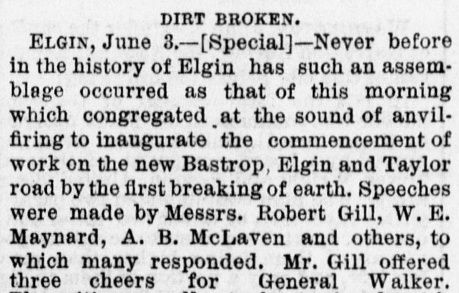 |
Left: The
Galveston Daily News of June 4, 1886 reported on a ceremony
at Elgin signifying the start of construction on the B&T. Elgin was
chosen because rail and other materials arriving at the Port of
Galveston could be shipped to Elgin on the H&TC. The article calls the railroad the "Bastrop,
Elgin and Taylor", perhaps an aspirational name but never an official
one. The TB&H name was formally adopted four months later when the
charter was amended.
Right:
The Fort Worth Daily Gazette
of June 17, 1887 reported completion of the Colorado River bridge at
Bastrop. As noted, Smithville got the branch line to Lockhart continuing to
San Marcos, but the San Antonio & Aransas Pass (SA&AP) was not involved.
By the end of 1887, the TB&H had been acquired by the Katy.
As rumored, the MP / Katy shops were built in Smithville. |
 |
The TB&H construction had continued beyond
Bastrop during the remainder of 1887, reaching Smithville and La Grange. Gould
also initiated construction on the branch line between San Marcos
and Smithville. Track-laying started at San Marcos and went east to Lockhart, but
it stopped there, 36 miles shy of Smithville, as dark financial clouds
began to impair Gould's activities. One of his railroads, the Wabash, St. Louis
& Pacific Railway, had entered receivership. It was indirectly leased to MP
thereby
affecting MP's operations and cash flow. On top of his problems outside of
Texas, Gould was under attack by new Texas Attorney General James S. (Jim) Hogg.
Hogg had been elected in November, 1886 on a campaign to go after railroads for
poor service, poor facilities and price-fixing.
As all of this was
happening, Gould was trying to prevent Katy stockholders from summoning a
quorum for a stockholders' meeting where they would undoubtedly fire him for the
detrimental impact of MP's lease. Gould had very little ownership in the Katy;
its stock was widely diluted and there were few large blocks available for
private purchase. This left Gould vulnerable to Katy stockholders, but only if
they could gather a quorum for an official meeting. Combined with the Wabash
bankruptcy and multiple lawsuits filed by Hogg, the situation in 1887 evolved
to the point where Gould ordered all MP construction to cease immediately. The
San Marcos - Smithville branch stopped at Lockhart, and the TB&H tracks stopped
eleven miles east of La Grange, a location christened Boggy Tank.
A turntable and siding tracks were installed so that passenger trains could serve the small
population in the vicinity.
Katy
stockholders were finally able to hold an official meeting in May, 1888 and they
fired Gould for malfeasance associated with MP's lease. New Katy management
promptly sought bankruptcy protection and a declaration that MP's lease was
void. Eventually, the Texas Supreme Court terminated MP's lease of the Katy
while also declaring the Katy to be a "foreign" railroad because it lacked a
Texas charter and headquarters. An 1870 Texas law had granted the Katy
permission to build into Denison from Indian Territory under the
authority of its Kansas railroad charter. The Supreme Court concluded that
the Katy should not have built further into Texas without a Texas charter and a
Texas headquarters. The Katy would operate under a court-appointed Receiver
until a proper Texas charter could be granted by the Legislature.
Gould
wanted to prevent the Katy from being allowed to retain ownership of the I&GN.
He was, ironically, still President of the I&GN. He had taken a risk using the Katy for his expansion plans; it was no secret
that the Katy lacked a Texas charter and headquarters. Gould's argument was that the Kansas charter
accepted for building into Denison also called for
the Katy to build south to Mexico, a plan he was basically following.
Texas legislators looked the other way; they enjoyed giving speeches to constituents
when towns celebrated the arrival of new MP / Katy tracks. In receivership, Katy
management was in no position to evict Gould from the I&GN, and it would have
had difficulty proving its ownership anyway. Gould had been sufficiently
concerned about the Katy's "foreign railroad" status that he had finessed the
actual ownership of the I&GN. Having acquired all of its stock certificates
in the swap for Katy stock, he placed them with his
close friend, Gen. Grenville Dodge, ostensibly a Texas resident at the time (in
Fort Worth), hence the stock was held at a
Texas headquarters, if you could call it that. Dodge was currently the Chief
Engineer for the Texas & Pacific Railway of which Gould was President, but he
was most famously known as the Chief Engineer for the
Transcontinental Railroad. Since Gould was focused on retaining the I&GN, he
decided to admit
to Hogg that the Katy
really was the I&GN's owner. By law, a foreign railroad could
not own a Texas railroad directly; it had to use an in-state subsidiary which
the Katy had not done. Hogg took the bait and jumped into the legal fray to try
to force the Katy to divest
the I&GN.
Gould engineered additional legal delay by putting the I&GN into bankruptcy over
a minor debt owed to himself that, as I&GN President, he had refused to
repay! Gould was ruthless but brilliant...
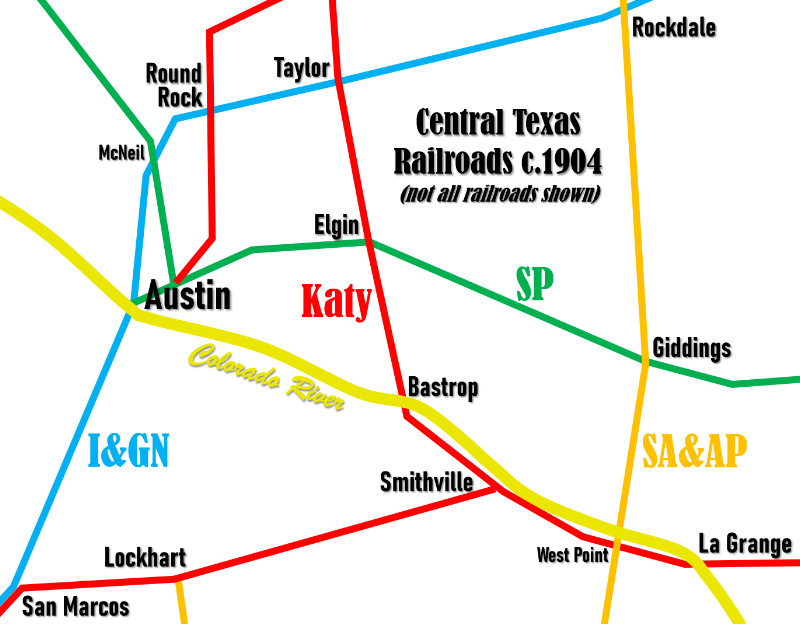 |
Left: This
overview map shows the railroads in the vicinity of Elgin c.1904.
It is apparent
that Gould's initial TB&H planning included the branch to San Marcos
because he otherwise could have avoided the expense of bridging the
Colorado River twice. Remaining north
of the river straight
from Bastrop to La Grange was a simpler alternative. Both town centers
were east and north of the river, hence no river crossing was needed to
proceed to Houston. The tracks would have passed along the river bank
across from Smithville and would likely have induced residents to shift
the town center to the north side of the river (it's only a quarter mile
south of the river today.) But crossing the Colorado River once --
necessary for a branch to San Marcos -- meant crossing it twice --
because the river turns south at La Grange.
Ultimately, there were numbered
interlocking plants at Elgin, Austin,
San Marcos, West
Point, Taylor,
Rockdale and McNeil. Giddings never had
a numbered interlocker despite gaining an additional rail line in 1914
when SP built the "Dalsa Cutoff" northeast from Giddings to Hearne.
There was no interlocker at Round Rock because the I&GN / Katy crossing
there was grade separated. |
The Legislature passed
the Katy charter law on October 28, 1891 granting rights to the Missouri, Kansas
& Texas Railway of Texas, a newly created subsidiary of the parent Katy corporation.
It would be headquartered
in Denison and would own most of the Katy's current Texas rail lines, but not
the I&GN; Gould's delaying tactics had worked. The Legislature had soured on the idea of allowing the
out-of-state Katy corporation to own Texas' largest
railroad through an artificial Texas subsidiary that existed solely on paper. The Katy had little choice but to sell the I&GN back to Gould
for a paltry sum. The
end result was that Gould had financial control of the I&GN but no
involvement with the Katy. Unfortunately, Gould did not have much time to adjust
to this new reality; he died in New York in December, 1892. His son George
replaced him as President of the I&GN.
Newly freed from MP's
yoke, the Katy resumed construction east from Boggy Tank in 1892 and
reached Houston in 1893. There, it filed suit against the I&GN, claiming
ownership of the Galveston, Houston & Henderson (GH&H) Railroad which had the
shortest and most direct rail line
between Houston and Galveston. Gould had bought the GH&H in 1882 and assigned it to the I&GN
since the two railroads had worked cooperatively in Houston for more than a
decade. The
Katy argued that since it had owned the I&GN at the time, it was the rightful
owner of the GH&H. George Gould negotiated a settlement wherein the Katy and the
I&GN would each have 50% ownership of the GH&H and unlimited rights to operate
over it.
The Katy also completed the San Marcos - Smithville branch line
in 1892 by finishing the 36-mile track segment between Lockhart and Smithville.
Since the Katy was no longer a Gould railroad, it had to negotiate a trackage
rights agreement with the I&GN south from San Marcos to reach San Antonio, a
major population center the Katy wanted to serve. Several years later, the Katy
was forced by the Legislature to build its own set of tracks between San Marcos
and San Antonio. Legislators wanted to improve rail competition in the San
Antonio market so they added this construction requirement when the Katy sought
an unrelated charter amendment in 1899; the new track segment was completed in 1901.
Three years later, the Katy built a line into Austin that departed its main at Granger,
eleven miles north of Taylor, and proceeded southwest through Georgetown and
Round Rock. The Katy negotiated rights to use the I&GN main line from Austin to
San Marcos where it connected with the Katy's Smithville branch and the new
tracks to San Antonio.
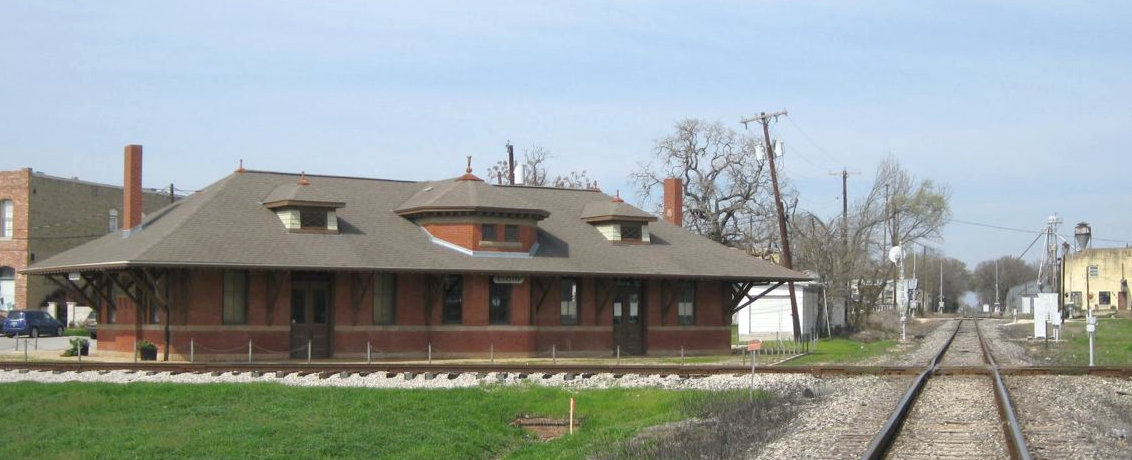
Above: In 1903, the two
railroads collaborated to build Elgin Union Depot in the northwest quadrant of
the crossing, replacing an earlier wood structure. After passenger service to
Elgin ended in 1957, the depot sat vacant and then was converted for use by the
Elgin Police Department for thirty years ending in 1990. After another vacant
period, the building reopened in 2002 hosting the
Elgin Depot Museum
operated by the Elgin Historical Association. This view looks north along the
Katy. (Dave Ingles photo, 2012)
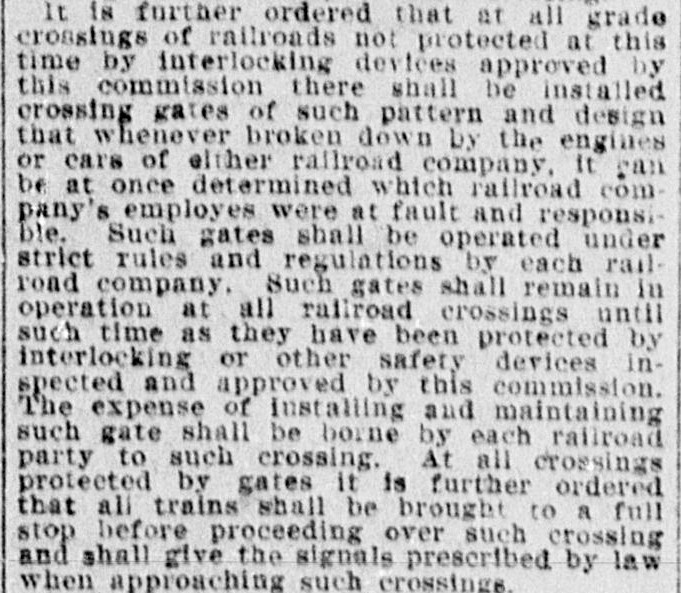 |
The 1886-1887 TB&H construction at
Elgin had crossed the H&TC at grade. By law, all trains were required to
stop before proceeding over any crossing diamond. This didn't have much
impact on trains through Elgin since the passenger and freight depots
were located close to the crossing, i.e. virtually all trains would be
stopping anyway. In 1901, a new law tasked the Railroad Commission of
Texas (RCT) to begin regulating safety systems for crossings of two or
more railroads. RCT had been created ten years earlier at the insistence
of the new Governor, Jim Hogg! Jay Gould's nemesis had been elected to a
higher office in 1890. Regulations issued pursuant to the 1901 law required railroads to
employ RCT-approved interlocking systems at crossings so that trains
could operate safely while avoiding unnecessary stops. On June 5, 1902,
RCT ordered 57 specific crossings to be interlocked within a year, but
Elgin was not among them.
Left: The Houston Daily
Post of June 6, 1902 carried RCT's order in full, including
this paragraph requiring gates installed at all grade crossings. Oddly, the
order instructs that gates were to be designed primarily as a tool for investigating which
railroad crashed into a gate! The order plainly required that, despite
the presence of gates, "...all trains shall be brought to a full stop
before proceeding..." Hence, there was little incentive for railroads to
spend money to install gates other than fear of RCT action for
non-compliance. Since all trains stopped anyway, gates had limited
positive impact on crossing safety. Railroads complied, albeit slowly in
many cases. When necessary, train crewmembers would disembark to swing a
gate across the other track and latch it to the opposite gatepost. Where
a track with infrequent traffic crossed a busy one, the gate would be
opened to allow passage and then returned to its normal position against
the lightly used line. At some point, trains began to approach gated
crossings at restricted speeds such that a full stop could be made if a
gate was observed to be closed, but the train could otherwise proceed
without stopping. It is unclear whether RCT ever authorized
"restricted speed" approaches. Permission may have evolved after the Interstate
Commerce Commission (ICC) gained greater responsibility for railroad
regulation in 1920. |
The objective of the 1901 law was to foster widespread
deployment of electromechanical interlocking technology incorporating trackside
signals and derails, devices that had long been used in other states. The new
regulations required RCT approval of the interlocking design at each
crossing, including a final inspection by RCT before the installed system could
become operational. RCT decided to adopt a numbering scheme for interlocking plants.
A number typically was assigned when a railroad began corresponding with RCT
during the design phase. Thus, interlocker numbers generally followed the
chronology of when tower plans were instigated, but they do not precisely
reflect the timing of when interlockers were commissioned for operation; some
towers simply took longer to implement. The first
to follow this process, Tower 1 at Bowie, was
commissioned for operation on April 17, 1902.
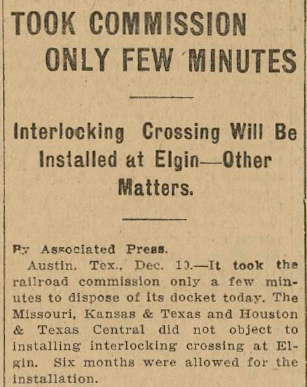 |
Over the years, RCT continued to order specific
crossings interlocked. Railroads could request a hearing to discuss or
dispute the need and offer pertinent testimony. Railroads sometimes solicited permission to interlock a crossing, but they often just waited
for RCT to act.
Left: RCT's order for an
interlocker at Elgin was announced verbally at a morning hearing on December 10, 1912
and reported that same evening in the
Galveston Tribune.
Right: RCT's order (issued 12-12-12) allowed six months for the interlocker
at Elgin to be installed.
It ultimately took fourteen months for
Tower 100 to open, on February 7, 1914. (RCT 1913 Annual Report) |
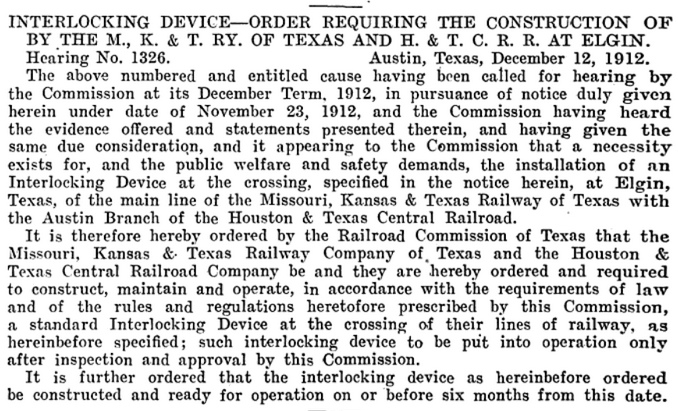 |
According to a table published annually by RCT, the
interlocking plant at Tower 100 was a mechanical type that initially hosted 29 functions.
This was substantially more than the normal minimum (twelve functions) indicating that the tower controlled
additional signals, derails and switches
for sidings and exchange tracks. The number of functions implemented by the
Tower 100 interlocker varied somewhat over the years, culminating with a function
count of 35 in the table published at the end of 1930 (after which RCT ceased
publishing an annual comprehensive interlocker table.) Beginning in 1915 (and in
subsequent years), RCT's table reported that SP
had the responsibility for operating Tower 100. SP probably had the additional responsibility
for tower and interlocker maintenance, as this was commonly coupled with
operational staffing. Recurring operations and maintenance (O&M) costs, e.g.
labor, materials and utilities, would
have been shared with the Katy using an agreed formula, typically the ratio of each railroad's
assigned interlocker functions compared to the total function count. At simple
crossings, this was usually 50 / 50, but an interlocker with 29 functions was
not simple; the precise expense split for Tower 100 is undetermined. It did not
take long for Elgin residents to learn which company employed the tower operators,
hence it was known as "the SP tower" around town. The Elgin Courier
of May 28, 1942 reported on the opening of a new Western Union office downtown
by reminding its readers that ... "After
5:30 pm each day messages are taken at the S. P. tower as here-to-fore."
That SP had staffing responsibility is no surprise because in the vast majority
of cases, the company that took the lead on designing and erecting a tower
also took responsibility for O&M staffing. And there is no doubt that Tower 100
was designed by SP. The exterior architecture matches that of virtually all
SP-designed towers in Texas, e.g. Tower 81,
Tower 95, Tower 115
and many others. A railroad would typically stay with a common architecture and
interior arrangement for the towers it designed. This reduced non-recurring
design expense by reusing specific features, with the added bonus that tower familiarity facilitated
easier movement of personnel among multiple sites for temporary staffing support. Since the tracks at Elgin
existed prior to 1901, RCT regulations required the two railroads to share
equally the capital cost of the tower and its interlocking plant.
|
Right: The January, 1928 edition of
Railway Signaling reported the Katy's plan to install a
"table lever interlocking" at Elgin. This type of interlocker
was based entirely on electric relays,
avoiding the need for large "armstrong" levers that mechanical interlockers
used for manipulating trackside devices. The frame for the control
machine would be small enough to be installed on a table where the
operator sat. The Katy taking the lead for this modification may
indicate that it had instigated the upgrade or ... perhaps the Katy was
responsible for Tower 100 maintenance and
engineering, at least as of 1928. RCT listed SP as responsible for tower operations
through its final report in 1930, but a split arrangement to staff operations and maintenance was certainly allowable, though
uncommon. |
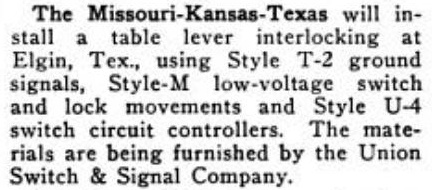 |
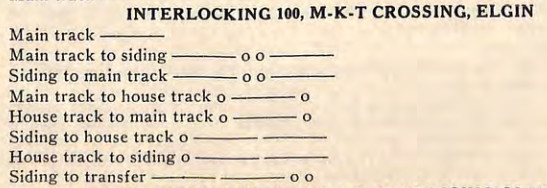 |
Left: SP's
employee timetable for its Dallas and Austin Divisions dated September
3, 1944 contained this table of whistle codes applicable to Tower 100.
Whistle codes provided a means for locomotives to signal the
tower to request specific switch and signal alignments.
The July 20, 1958 Katy employee timetable lists the Tower 100 interlocker as automatic, but the preceding March 1, 1957 Katy timetable
does not. This suggests that the conversion to an automatic interlocker occurred between those dates.
Manual override controls for the Elgin automatic interlocker are located
in the boxes atop the white trackside post to the far right in the Union Depot
photo above. |
This excerpt from an article by Lisa Johnson (hat tip Ann Helgeson)
in the Bastrop County Times of May 4, 1978
recounts an interview with
Mrs. W. M. Griffin of Elgin who provided her recollections of tower operations.
Her family had moved to Elgin in 1908 and she recalled seeing gates at the crossing as a young
child.
Mrs. W M Griffin, wife of the telegraph operator Bill Griffin,
remembers those early days. "We moved into town when I was a
little girl, in 1908, and I remember the big red depot as being
brand new. My father was with the cotton oil mill, and like a
lot of families, we moved to Elgin because the railroads made
it a center of activity and business." Mrs. Griffin's late husband operated the semaphore for the
Southern Pacific out of the little telegraph tower which was
moved to Avenue F from its original site adjacent to the Union
Station. She remembers that before the telegraph came, crossing
gates were used to regulate the trains where the KATY and SP lines
crossed. There were always three shifts or "tricks" for the
telegraph operators so that someone was always looking there
to give signals to the switchmen and avoid a collision. Griffin
was first trick (7 am to 3 pm), H G Davis whose wife, Sadie Bell
still lives in Elgin, was second trick (3-11 pm) and N R Radtke
was third trick, the night shift (11 pm - 7 am). Radtke started
with the SP in 1930 as a telegraph operator and retired in 1963
as a freight agent, a job that he took in 1957. "When I first
came to Elgin we had a switching tower and we worked for both
trains. During the War years, there was a great shortage of men
who could do the job that had to be done, so we trained young
men who hadn't gone to the service as telegraph operators. I guess I must've trained 50 or so during that time." Radtke said that for most of his working years, it was a
"...24-hour
job, seven days a week. There was not time off, someone always
had to be there." When Radtke started, there were no diesels.
He remembered the changeover. "It was a gradual transition
to diesel about 30 years ago. I remember General Electric, out
of Philadelphia, loaned the Katy two diesels, and they wore them
slap-dab out running them so much."
Asked if he had ever experienced a train wreck in his years with
the railroad he indicated there were many collisions for a variety
of reasons. Once a freight train coming south and an empty train coming
north from Camp Swift collided. Another particularly bad wreck
he remembered occurred between some gravel cars that had rolled
three miles out of a side track onto the main track. The engineer
of the oncoming train and his son were killed. Radtke estimated
he has seen 50 or more wrecks.
In 1915, the Katy entered a receivership that lasted
until 1923. It emerged from bankruptcy with a slight name change, the Missouri - Kansas - Texas Railroad,
hence M-K-T, MKT and MK&T have all been used as acronyms for the Katy. The Katy
remained independent into the 1980s, but by then it had been struggling to
sustain its existence for many years. In 1989, it was acquired by Union Pacific
(UP) and merged into MP which had become a UP subsidiary in 1982. The merger of
the Katy into MP was one hundred years after MP's lease of the Katy had been
terminated by the Texas Supreme Court. And as before, all operations were
conducted under the MP name.
| Right:
The Union Depot is clearly visible in this 1959 image ((c)historicaerials.com),
but is the tower located across from it? The photo at the top of the
page and another below shows that the tower was located close to the
diamond and that there were no structures on its east side. But this
image shows what appears to be a light color equipment cabinet casting a shadow to the north
located a short distance east of the crossing. It's unclear precisely what is
visible at the east corner of the
diamond. Perhaps it's the tower in a state of being dismantled for
relocation? An automatic interlocker was installed to replace the tower sometime between
March, 1957 and July, 1958. |
 |
In August, 1961, SP requested permission from the
ICC to abandon the tracks between Hempstead and Brenham
knowing that the Brazos River bridge would not survive the next flood and that rail
traffic on the line was insufficient to justify rebuilding it. The tracks were embargoed the following month due to floodwaters caused by Hurricane Carla
and then officially abandoned between Hempstead and Brenham in 1962. The next
phase of abandonment was between Brenham and
Giddings in 1979. ICC approved the request as there was no traffic moving regularly
over the tracks and both endpoints retained rail service on other lines. In
1986, SP sold the tracks between Giddings and Llano to the City of Austin which
wanted to preserve the right-of-way for a potential commuter or light rail line.
The City leased the line for continued freight operations to RailTex, which established a new Austin & Northwestern to be the
operating railroad. In 1996, the Longhorn Railroad took over operations on the
line with freight service beginning May 6th. Yet another operating change was
made in April, 2000 when the City leased the line to the Austin Area Terminal
Railroad. The line has been
operated since October 1, 2007 by the Austin & Western Railroad (AWRR), a
subsidiary of transportation services company Watco. East of Austin, AWRR serves businesses in Manor, Elgin and Giddings.
Elsewhere, SP had maintained a robust presence throughout Texas,
continuing into the 1990s. Industry-wide consolidations forced SP to acquiesce
to a merger with UP in 1996. Within a couple of years, all operations in the UP
system were being conducted under the UP name; operationally, MP and SP ceased
to exist.
 |
Left:
undated photo of Tower 100 and Elgin Union Depot (James E. Hassell collection)
Below:
Tower 100 was relocated to Avenue F near Booker T. Washington Elementary
School, not far from the Katy tracks and within a half mile of the
crossing. Unfortunately, it was allowed to fall into complete disrepair
and was ultimately razed, probably in the late 1980s. This photo at its Avenue F location
appeared in the Bastrop
County Times on May 4, 1978. (courtesy Ann Helgeson, Elgin Historical
Association and Elgin Union Depot Museum)
 |


Above: two photos
of Tower 100 at its Avenue F location (Con Sweet photos, March, 1984) |
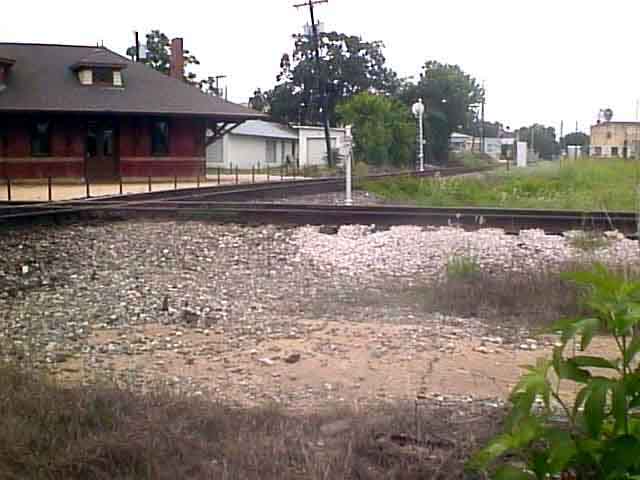
Above: Tower 100's
foundation (Ann Helgeson photo) |
Right: R.J. McKay writes:
"Well, here's a latter
day picture of Elgin from when I worked on the Austin and Northwestern
Railroad.
I was the Engineer and Lanny Farley was the Conductor, both known
as TranSpecs, or Transportation Specialists on the RailTex properties.
Tower 100 was replaced with a signal box and on the opposite
side of the track are the time release boxes, one for the AUNW
and one for the Katy. Old H&TC Freight depot on the
left in the background and the Union Depot on the right." |
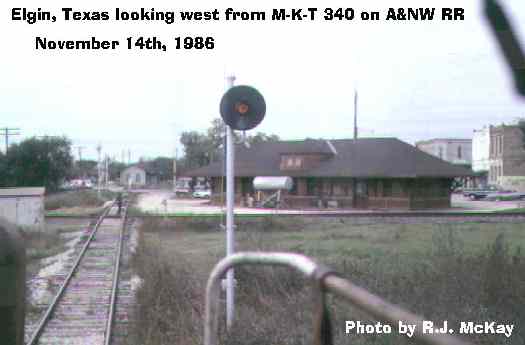 |

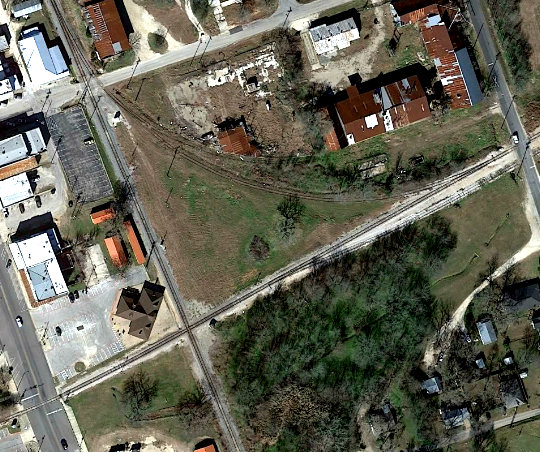
Above Left: This Google
Street View image from June 2016 shows an automatic interlocker cabin in the southeast quadrant of the diamond
where Tower 100 once stood. The interlocker
override controls are on the post across from it in the northeast quadrant. Above Right:
The Tower 100 crossing is near the center of Elgin on the southeast corner of
downtown. This 2022 Google Earth satellite view shows the former Katy tracks
intact generally north / south and the former SP tracks intact generally east /
west, with a connecting track in the northeast quadrant. A track chart of Elgin c.1920
produced by SP (hat tip, Stuart
Schroeder) shows there was also a connecting track in the southeast quadrant,
but there is no evidence of it in the satellite image above. While both rail lines remain active, Federal Railroad Administration
grade crossing records show that in 2019, UP was operating an average of only two
trains daily on the former Katy tracks through Elgin which had been relegated to
secondary status. Grade crossing information from October, 2023 reported an
average of two trains per week on the AWRR through Elgin.
Although UP / AWRR traffic exchange is feasible at Elgin, the primary
interchange is at McNeil.
Below: These photos of a Tower 100
model built by Jim Zwernemann were taken at the
Katy House Bed & Breakfast in Smithville in August, 2006. Credit to Bruce Blalock for making the
arrangements. Thanks, Bruce! (Jim King photos)
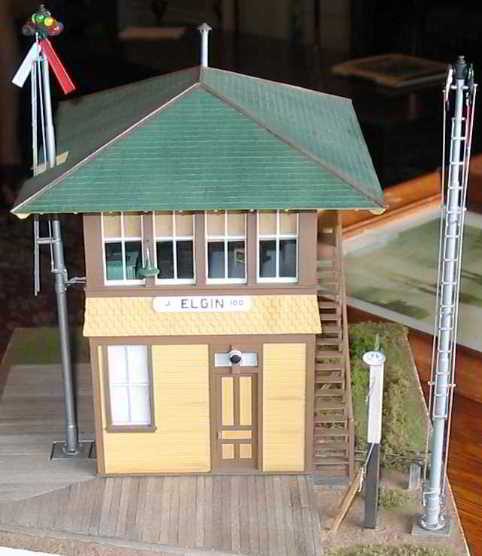



Last Revised: 7/23/2024 - Contact the Texas
Interlocking Towers website.


























